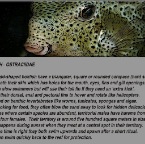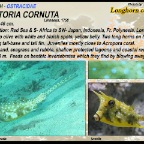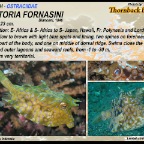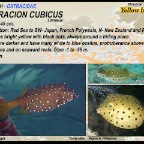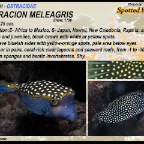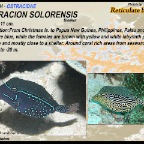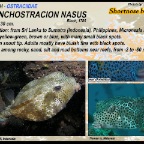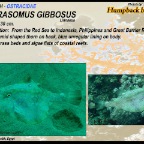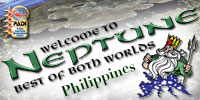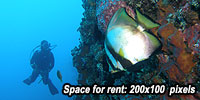Boxfish - Tetraodontidae
BOX FISH - OSTRACIIDAE
These odd-shaped boxfish have a triangular, square or rounded carapace (hard shell) underneath their skin which has holes for the mouth, eyes, fins and gill openings. They are slow swimmers but will use their tail fin if they need an ‘extra kick’. They use their dorsal, anal and pectoral fins to hover and rotate like helicopters. Boxfish feed on benthic invertebrates like worms, tunicates, sponges and algae. When looking for food, they often blow the sand away to look for hidden delicacies. On places where certain species are abundant, territorial males have harems from around three to four females. Their territory is around five hundred square meters in size. Mating happens during sunset when they meet at a central spot in their territory. When the time is right they both swim upwards and spawn after a short ritual. They then swim quickly back to the reef for protection. Length: 30 cm.
Distribution: from the Red Sea to Indonesia, Philippines and Great Barrier Reef.
Big pyramid shaped thorn on back, blue unregular lining on body.
On seagrass beds and algae flats of coastal reefs. Length: 30 cm.
Distribution: from E- Africa to S- Japan, Fiji and Great Barrier Reef.
Grey to yellow-green or brown with many small black spots.
Bump on snout tip. Adults mostly have bluish fins with black spots.
Lives solitary among rocky and sandy bottoms near reefs, from -2 to 80 m. Length: 11 cm.
Distribution: from Christmas Is. to Papua New Guinea, Philippines, Palau and N- GBR.
Males are blue, while the females are brown with yellow and white labyrinth pattern.
Very shy and mostly close to a shelter. Around coral rich areas from seaward reefs.
From -1 to -20 m. Length: 25 cm.
Distribution:E- Africa to Mexico, S- Japan, Hawaii, New Caledonia, Rapa Is. and G.B.R.
Females and juveniles, black-brown with white or yellow spots.
Males have blueish sides with yellow-orange spots, pale area below eyes.
Solitary or in pairs, coral-rich clear lagoons and seaward reefs, from -1 to -30 m.
Feeds on sponges and bentic invertebrates. Shy. Length: 45 cm.
Distribution: Red Sea to SW- Japan, French Polynesia, N- New Zealand and Rapa Is.
Juveniles bright yellow with black dots, always around a hiding place.
Adults are darker and have many white to blue ocellus, protruberance above upper lip.
In lagoons and on seaward reefs, from -1 to -35 m. Common. Length: 23 cm.
Distribution: E- Africa & S- Africa to S- Japan, Hawaii, Fr. Polynesia and Lord Howe Is.
Dark yellow to brown with light blue spots and lining, two spines on forehead, rear
bottom part of the body, and one on middle of dorsal ridge. Swims close the substrate,
protected outer lagoons and seaward reefs, from -1 to -30 m. Males are very territorial. Length: 46 cm.
Distribution: From the Red Sea to French Polynesia, S- Japan and Lord Howe.
Yellow to brown colour, two long horns on forehead. Usually above sand, seagrass
and rubble of shallow protected lagoons and coastal reefs. From -1 to -50 m.
Feeds on benthic invertebrates which they find by blowing away sand.


